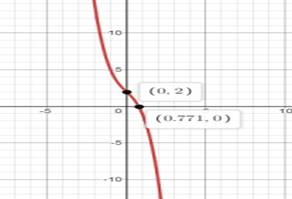
(a)
To find: Thevertical and horizontal asymptote of the function.
(a)
Answer to Problem 7RE
There is no Horizontal and vertical asymptote in the function.
Explanation of Solution
Given:
Concept used:
If the degree of the numerator is more than the denominator, there is no horizontal asymptote.
If the denominator has no zeroes then there has no vertical asymptotes
Or
To get Vertical asymptote function should be rational and denominator must contain some variable otherwise there has no vertical asymptote.
Calculation:
Accordingto the laws of asymptotes:
If the degree of the numerator is more than the denominator, there is no horizontal asymptote.
If the denominator has no zeroes then there has no vertical asymptotes.
Here degree of the numerator is
Hence, there is no Horizontal and vertical asymptote in the function.
(b)
To find: TheInterval of increasing or decreasing of the function.
(b)
Answer to Problem 7RE
The function is not real or imaginary so it doesn’t have any zeroes.
The function is neither increasing nor decreasing.
Explanation of Solution
Given:
Concept used:
Increasing or decreasing function can be calculated by equating first derivative of the function to 0.
Zeroes of x can be calculatedafter that the increasing and decreasing can be measured.
Calculation:
Increasing or decreasing function can be calculated by equating first derivative of the function to 0.
Since the function is not real or imaginary so it doesn’t have any zeroes.
Hence the function is neither increasing nor decreasing.
(c)
To find: The
(c)
Answer to Problem 7RE
There is no minima and
Explanation of Solution
Given:
Concept used:
The local maxima and minima can be calculated by firstly equating the double differentiation to 0.
1.
2.If
3.
Calculation:
Hence, there is no minima and maxima since the function come up with imaginary.
(d)
To find: The interval of concavity and the inflection point.
(d)
Answer to Problem 7RE
Interval of concavity is from
Explanation of Solution
Given:
Concept used:
The second derivative of function is calculated first.
Set the second derivative equal to zero and solve.
Check whether the second derivative undefined for any values of x.
Plot the number on number line and test the regions with the second derivative.
Plug these 3 values for obtain three inflection points.
The graph of
The graph of
If the graph of
Calculation:
Hence,
Interval of concavity is from
(e)
To Sketch:the graph using graphing use the information from part a to d.
(e)
Answer to Problem 7RE
it’s verified from the graph
Interval of concavity is from
Explanation of Solution
Given:
Concept used:
The graph can be generated from graphing device called Desmos graphing calculator.
Calculation:
The graph of the function

Hence, it’s verified from the graph
Interval of concavity is from
Chapter 4 Solutions
Single Variable Calculus: Concepts and Contexts, Enhanced Edition
- Explain the focus and reasons for establishment of 12.5.3 about alternating series. and explain the reason why (sigma k=1 to infinite)(-1)k+1/k = 1/1 - 1/2 + 1/3 - 1/4 + .... converges.arrow_forwardExplain the key points and reasons for the establishment of 12.3.2(integral Test)arrow_forwardUse identity (1+x+x2+...+xn)*(1-x)=1-xn+1 to derive the result of 12.2.2. Please notice that identity doesn't work when x=1.arrow_forward
- 8. For x>_1, the continuous function g is decreasing and positive. A portion of the graph of g is shown above. For n>_1, the nth term of the series summation from n=1 to infinity a_n is defined by a_n=g(n). If intergral 1 to infinity g(x)dx converges to 8, which of the following could be true? A) summation n=1 to infinity a_n = 6. B) summation n=1 to infinity a_n =8. C) summation n=1 to infinity a_n = 10. D) summation n=1 to infinity a_n diverges.arrow_forwardPLEASE SHOW ME THE RIGHT ANSWER/SOLUTION SHOW ME ALL THE NEDDED STEP 13: If the perimeter of a square is shrinking at a rate of 8 inches per second, find the rate at which its area is changing when its area is 25 square inches.arrow_forwardDO NOT GIVE THE WRONG ANSWER SHOW ME ALL THE NEEDED STEPS 11: A rectangle has a base that is growing at a rate of 3 inches per second and a height that is shrinking at a rate of one inch per second. When the base is 12 inches and the height is 5 inches, at what rate is the area of the rectangle changing?arrow_forward
 Calculus: Early TranscendentalsCalculusISBN:9781285741550Author:James StewartPublisher:Cengage Learning
Calculus: Early TranscendentalsCalculusISBN:9781285741550Author:James StewartPublisher:Cengage Learning Thomas' Calculus (14th Edition)CalculusISBN:9780134438986Author:Joel R. Hass, Christopher E. Heil, Maurice D. WeirPublisher:PEARSON
Thomas' Calculus (14th Edition)CalculusISBN:9780134438986Author:Joel R. Hass, Christopher E. Heil, Maurice D. WeirPublisher:PEARSON Calculus: Early Transcendentals (3rd Edition)CalculusISBN:9780134763644Author:William L. Briggs, Lyle Cochran, Bernard Gillett, Eric SchulzPublisher:PEARSON
Calculus: Early Transcendentals (3rd Edition)CalculusISBN:9780134763644Author:William L. Briggs, Lyle Cochran, Bernard Gillett, Eric SchulzPublisher:PEARSON Calculus: Early TranscendentalsCalculusISBN:9781319050740Author:Jon Rogawski, Colin Adams, Robert FranzosaPublisher:W. H. Freeman
Calculus: Early TranscendentalsCalculusISBN:9781319050740Author:Jon Rogawski, Colin Adams, Robert FranzosaPublisher:W. H. Freeman
 Calculus: Early Transcendental FunctionsCalculusISBN:9781337552516Author:Ron Larson, Bruce H. EdwardsPublisher:Cengage Learning
Calculus: Early Transcendental FunctionsCalculusISBN:9781337552516Author:Ron Larson, Bruce H. EdwardsPublisher:Cengage Learning





